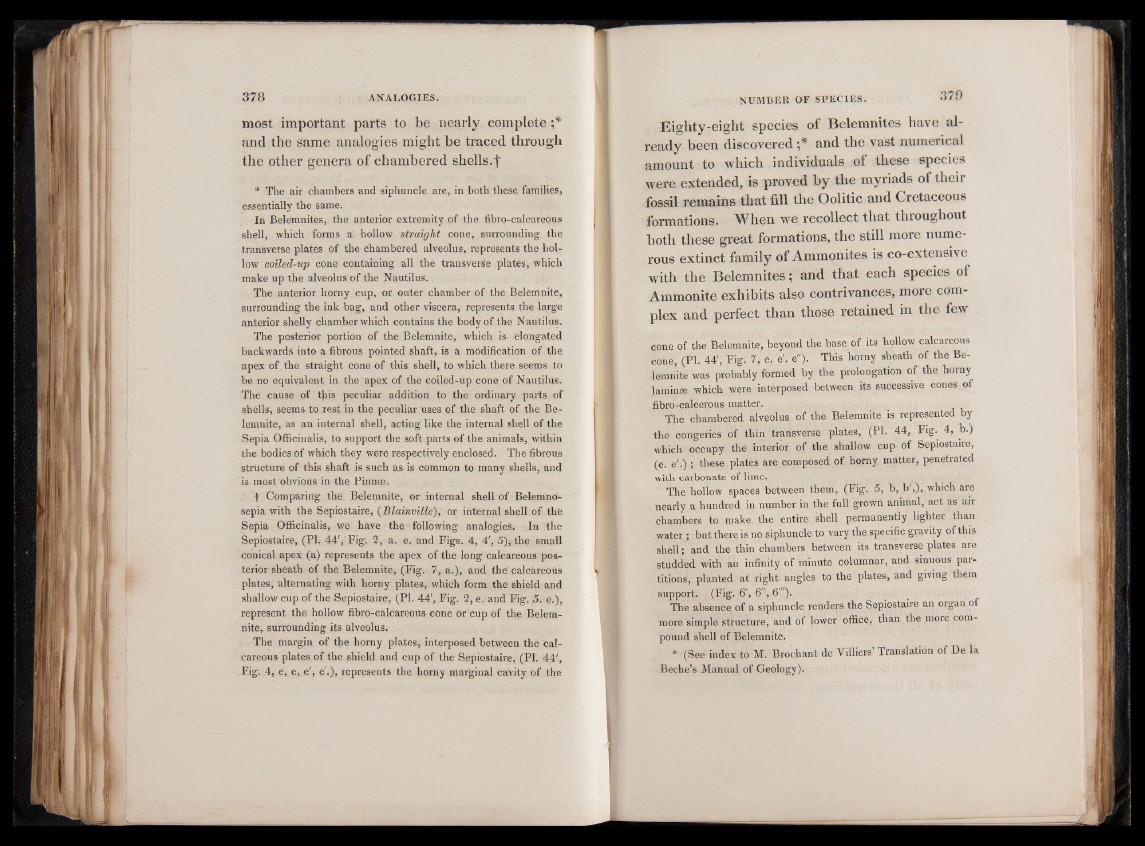
most important parts to be nearly complete ;*
and the same analogies might be traced through
the other genera of chambered shells.t
* The air chambers and siphuncle are, in both these families,
essentially the same.
In Belemnites, the anterior extremity of the fibro-calcareous
shell, which forms a hollow straight cone, surrounding the
transverse plates of the chambered alveolus, represents the hollow
coiled-up cone containing all the transverse plates, which
make up the alveolus of the Nautilus.
The anterior horny cup, or outer chamber of the Belemnite,
surrounding the ink bag, and other viscera, represents the large
anterior shelly chamber which contains the body of the Nautilus.
The posterior portion of the Belemnite, which is elongated
backwards into a fibrous pointed shaft, is a modification of the
apex of the straight cone of this shell* to which there seems to
be no equivalent in the apex of the coiled-up cone of Nautilus.
The cause of this peculiar addition to the ordinary parts of
shells, seems to rest in the peculiar uses of the shaft of the Belemnite,
as an internal shell, acting like the internal shell of the
Sepia Officinalis, to support the soft parts of the animals, within
the bodies of which they were respectively enclosed. The fibrous
structure of this shaft is such as is common to many shells, and
is most obvious in the Pinnee.
f Comparing the Belemnite, or internal shell of Belemno-
sepia with the Sepiostaire, (Blainville), or internal shell of the
Sepia Officinalis, we have the following analogies. In the
Sepiostaire, (PI. 44', Fig. 2, a. e. and Figs. 4, 4', 5), the small
conical apex (a) represents the apex of the long calcareous posterior
sheath of the Belemnite, (Fig. 7, a.), and the'calcareous
plates, alternating with horny plates, which form the shield and
shallow cup of the Sepiostaire, (PI. 44', Fig. 2, e. and Fig. 5. e.),
represent the hollow fibro-calcareous cone or cup of the Belemnite,
surrounding its alveolus.
The margin of the horny plates, interposed between the calcareous
plates of the shield and cup of the Sepiostaire, (PI. 44',
Fig. 4, e, e, e', e'.), represents the horny marginal cavity of the
Eighty-eight species of Belemnites have already
been discovered ;* and the vast numerical
amount to which individuals of these species
were extended, is proved by the myriads of their
fossil remains that fill the Oolitic and Cretaceous
formations. When we recollect that throughout
both these great formations, the still more numerous
extinct family of Ammonites is co-extensive
with the Belemnites; and that each species of
Ammonite exhibits also contrivances, more complex
and perfect than those retained in the few
cone of the Belemnite, beyond the base of its hollow calcareous
cone, (PI. 44', Fig- 7, e. e'. e"). This horny sheath of the Belemnite
was probably formed by the prolongation of the horny
laminse which were interposed between its successive cones of
fibro-calcerous matter.
The chambered alveolus of the Belemnite is represented by
the congeries of thin transverse plates, (PI. 44, Fig. 4, b.)
which occupy the interior of the shallow cup of Sepiostaire,
(e. e'.) ; these plates are composed of horny matter, penetrated
with carbonate of lime.
The hollow spaces between them, (Fig. 5, b, b',), which are
nearly a hundred in number in the full grown animal, act as air
chambers to make the entire shell permanently lighter than
water ; but there is no siphuncle to vary the specific gravity of this
shell; and the thin chambers between its transverse plates are
studded with an infinity of minute columnar, and sinuous partitions,
planted at right angles to the plates, and giving them
support. (Fig. 6', 6", 6"').
The absence of a siphuncle renders the Sepiostaire an oigan of
more simple structure, and of lower office, than the more compound
shell of Belemnite.
* (See index to M. Brochant de Villiers’ Translation of De la
Beche’s Manual of Geology).